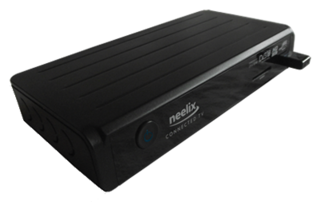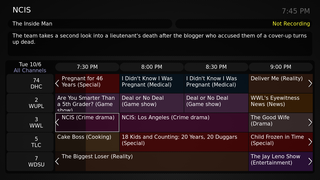
A set-top box (STB), also known as a cable box or receiver and historically television decoder, is an information appliance device that generally contains a TV-tuner input and displays output to a television set and an external source of signal, turning the source signal into content in a form that can then be displayed on the television screen or other display device. They are used in cable television, satellite television, and over-the-air television systems as well as other uses.
Video on demand (VOD) is a media distribution system that allows users to access videos, television shows and films without a traditional video playback device and a typical static broadcasting schedule. In the 20th century, broadcasting in the form of over-the-air programming was the most common form of media distribution. As Internet and IPTV technologies continued to develop in the 1990s, consumers began to gravitate towards non-traditional modes of content consumption, which culminated in the arrival of VOD on televisions and personal computers.

Interactive television is a form of media convergence, adding data services to traditional television technology. It has included on-demand delivery of content, online shopping, and viewer polls. Interactive TV is an example of how new information technology can be integrated vertically into established technologies and commercial structures.
Adelphia Communications Corporation was an American cable television company with headquarters in Coudersport, Pennsylvania. It was founded in 1952 by brothers Gus and John Rigas after the pair purchased a cable television franchise for US$300. Combining various cable properties, the company became one of the most successful in the United States and reached over two million subscribers in 1998. In addition to cable television, Adelphia later started providing high-speed internet, phone services and voice messaging for businesses.

Liberty Media Corporation is an American mass media company founded by John C. Malone in 1991. The company has three divisions, reflecting its ownership stakes in Formula One, Sirius XM, and Live Nation Entertainment.
An access network is a type of telecommunications network which connects subscribers to their immediate service provider. It is contrasted with the core network, which connects local providers to one another. The access network may be further divided between feeder plant or distribution network, and drop plant or edge network.

Internet Protocol television (IPTV) is the delivery of television content over Internet Protocol (IP) networks. This is in contrast to delivery through traditional terrestrial, satellite, and cable television formats. Unlike downloaded media, IPTV offers the ability to stream the source media continuously. As a result, a client media player can begin playing the content almost immediately. This is known as streaming media.

Electronic programming guides (EPGs) and interactive programming guides (IPGs) are menu-based systems that provide users of television, radio and other media applications with continuously updated menus that display scheduling information for current and upcoming broadcast programming. Some guides also feature backward scrolling to promote their catch up content. They are commonly known as guides or TV guides.
Bright House Networks, LLC also simply known as Bright House, was an American telecom company. Prior to its purchase by Charter Communications, it was the tenth-largest multichannel video service provider and the 6th largest cable internet provider in the United States. The company served more than 2.2 million customers.

Nick Rocks: Video to Go, usually shortened to Nick Rocks, was a music video television series that aired on American cable channel Nickelodeon from 1984 to 1989. It featured pop and rock music videos over a 30-minute timeframe, presented in a countdown format. The show was typically hosted by a man identified on-air as "Joe from Chicago". Most episodes feature Joe traveling to various locations to hear viewers request specific music videos. Several guest hosts were featured over the program's run, such as The Monkees and They Might Be Giants.
Barry Martin Schuler is an American Internet entrepreneur and former chairman and CEO of America Online Inc. He is best known for leading the AOL team that simplified the online service provider's user interface, making it possible for millions of consumers to gain easy access to the Internet.
SportsNet Pittsburgh is an American regional sports network owned as a joint venture between the Pittsburgh Penguins and the Pittsburgh Pirates. It is operated by sister network NESN through common ownership with Fenway Sports Group. Headquartered in Pittsburgh, the channel broadcasts local coverage of sports events throughout Greater Pittsburgh and western Pennsylvania. It is the exclusive home of the Pittsburgh Penguins and the Pittsburgh Pirates.

Root Sports Northwest is an American regional sports network owned as a 71/29 joint venture between the Seattle Mariners and Warner Bros. Discovery. Headquartered near Seattle in the city of Bellevue, Washington, the channel broadcasts regional coverage of sports events throughout the Pacific Northwest, with a focus on professional sports teams based in Seattle and Portland. It is available on cable providers throughout Washington, Oregon, Idaho, Montana, and Alaska and nationwide on satellite via DirecTV.

Fox Sports Net Chicago was an American regional sports network that was headquartered in Chicago, Illinois and was owned by Cablevision for most of its history. News Corporation acquired a minority ownership interest in the network in 1997, which Cablevision bought out in 2005. The network was affiliated with SportsChannel from 1987 to 1997, when it became an affiliate of Fox Sports Net.
Major League Baseball games not broadcast exclusively by its media partners are televised by regional sports networks, which present sports programming of interest to their respective region. Most MLB broadcasters are members of chains such as NBC Sports Regional Networks and Bally Sports, although several teams are broadcast by regional networks that are independent of these chains. Some teams own partial or majority stakes in their regional broadcaster.
Scripps Networks Interactive, Inc. (SNI) was an American mass media company, which was formed on July 1, 2008, and acquired by and merged into Discovery Communications on March 6, 2018. It was formed in 2008, through the spin-off of the E. W. Scripps Company's cable television networks and online assets. Discovery Communications completed its acquisition of SNI after receiving approval from the United States Department of Justice and European Commission on March 6, 2018. It was the owner of several major factual television cable channels, including Food Network, HGTV and Travel Channel, and operated or held stakes in localized international versions of these brands. SNI also owned Polish broadcaster TVN and half of the British channel group UKTV.

QUBE was a former experimental two-way, multi-programmed cable television system that played a significant role in the history of American interactive television. It was launched in Columbus, Ohio, on 1 December 1977. Highly publicized as a revolutionary advancement, the QUBE experiment introduced viewers to several concepts that became central to the future development of TV technology: pay-per-view programs, special-interest cable television networks, and interactive services. It went defunct in 1984.
AT&T SportsNet Rocky Mountain, temporarily rebranded as SportsNet Rocky Mountain, is a soon-to-be defunct American regional sports network owned by Warner Bros. Discovery through its TNT Sports unit as part of the AT&T SportsNet brand of networks. Headquartered in Denver, Colorado, the network broadcasts regional coverage of sports events throughout the Rocky Mountain region, mainly focusing on professional sports teams based in the Denver metropolitan area, Utah and Nevada.

TV Everywhere refers to a type of American subscription business model wherein access to streaming video content from a television channel requires users to "authenticate" themselves as current subscribers to the channel, via an account provided by their participating pay television provider, in order to access the content.
AT&T Sports Networks, LLC (ATTSN) was a group of regional sports networks in the United States that primarily own and operate AT&T Sports Networks. It is owned by Warner Bros. Discovery through TNT Sports. Each of the networks carry regional broadcasts of sporting events from various professional, collegiate and high school sports teams.









